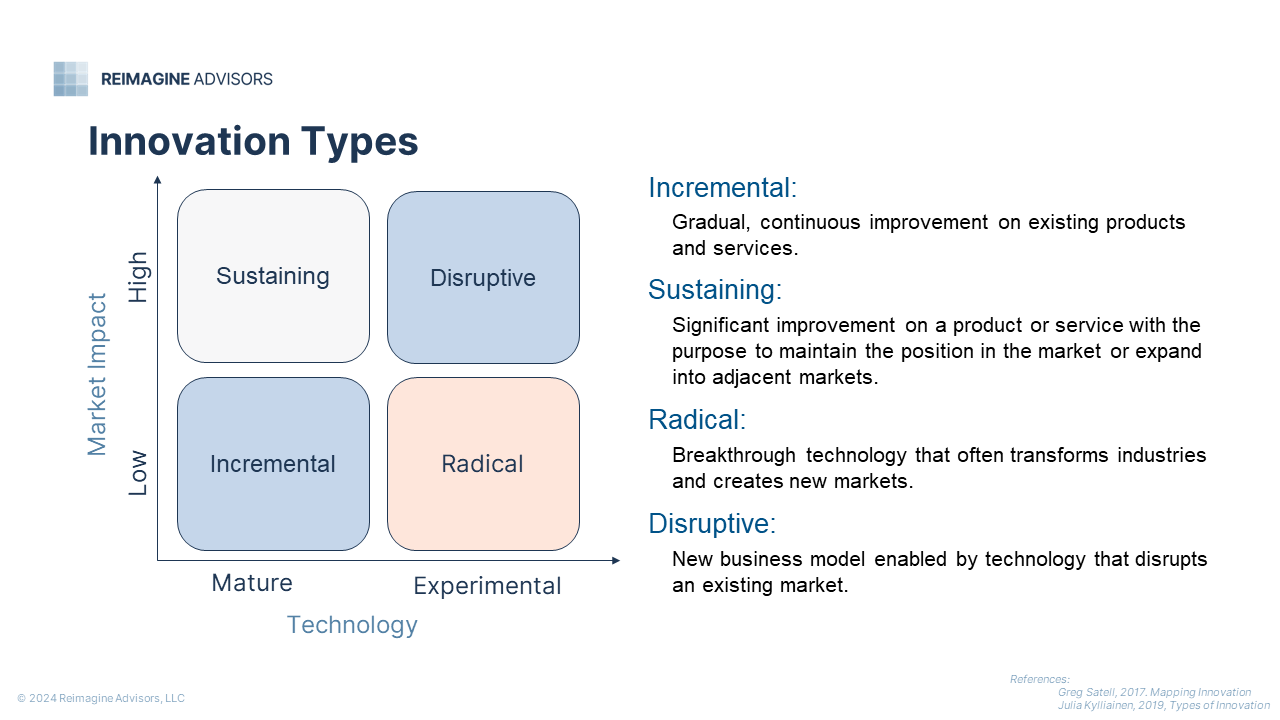
Denis Stypulkoski,
Founder and Principal,
Reimagine Advisors

Brianna Wilson,
Editor,
Monitor
Innovation is many things. Some see it as a simple buzzword and gloss over it in headlines. Many consider it the “new way to be” and are striving to turn their companies into innovative leaders that create the path to the future. True innovators, like Denis Stypulkoski, consider it to be an art and a science that requires careful navigation and experimentation to master.
Stypulkoski’s work, as the founder and principal of Reimagine Advisors, involves coaching clients on how to create innovation programs within their companies. Stypulkoski and his business partner, Christina Colabella Wilds, have conducted research and explored the different approaches to and types of innovation, both within and outside of the equipment finance industry. The team often uses a practical, meaningful and simple graph (Figure 1) to help clients navigate through self-reflection practices surrounding what it takes to become an innovative company.

The graph approaches the quadrants of innovation in terms of market impact, with its vertical axis representing low market impact to high market impact. Its horizontal axis represents technology maturity, from mature and relatively safe technologies to experimental and far-reaching technologies that even risk disappearing entirely because they don’t prove out.
FOUR TYPES OF INNOVATION
The diagram introduces four types of innovation: incremental, sustaining, radical and disruptive.
NAVIGATING THE QUADRANTS
A large area of focus for Stypulkoski is helping companies determine where they are, where they would like to be and how to navigate the four areas of innovation. This starts with an inventory of questions to take stock of a company’s current competencies, skills, capabilities, growth aspirations and risk appetite. Stypulkoski refers to this as the “posture” of an organization which, similar to a financial advisor who takes clients through a series of questions to establish a profile, evaluates how a company thinks about, reacts to and implements innovation. This is often influenced by how the overall industry or market treats innovation, and is directly linked to how leadership acts upon it.
“If you’re below incremental, you’re in survival and reactive mode. You’re basically waiting for something to happen to you before you make change and create something new,” Stypulkoski says. “A company or a leader that’s in the disruptive arena has a very bold posture.”
Stypulkoski says the road to innovation is a journey, and certainly not a walk in the park.
A reactive company or a leadership team can’t upend all competencies, skills, methodologies,
technologies and experiences to suddenly become a disruptive company, even with extensive planning. A long-term plan works against innovation efforts, Stypulkoski says, because companies cannot know what will emerge in the time it takes to implement a years-long plan. Instead, the journey from 100% reactive to 100% bold should be a learning experience.
Realistically, it’s not viable to go from one extreme to another. Starting small is important.
By taking stock of current methodologies, Stypulkoski has seen clients comprehend the full extent of their innovative work, which was much greater than they initially realized. Innovation can occur at any level of the organization. If it exists in just one or two teams, companies can begin to offer more resources to continue and expand upon those innovative efforts. Other companies may allocate resources to a team dedicated to pushing the company into the disruptive and radical arena. “That’s where leadership vision, leadership investment and organizational posture come into play — in helping you to expand either horizontally or vertically from the area of comfort where you’re currently playing,” Stypulkoski says.
PLAYING AT WORK
Innovation requires a level of creativity that the average business person doesn’t have time to foster. It almost requires channeling a childlike curiosity and level of thinking outside the box to adopt forward-thinking ideas that work long-term.
Truly innovative companies embrace intentional innovation, making time for their people to explore. Google encourages employees to spend 20% of their time exploring ideas and projects that they believe will benefit the company.1 This “playtime” could introduce a new tool, process or idea that becomes integral to Google’s operations.
“As kids, we sat through courses, and then we had recess and playtime,” Stypulkoski says. “That concept really is embodied within some of the contemporary frameworks that organizations can embrace to become agile innovators.”
Kids also aren’t afraid to fail. Unfortunately, companies are — especially big companies, and
Stypulkoski knows he can’t just tell large financial institutions to “fail fast.” Reimagine Advisors flips that narrative and empowers companies to learn fast. Done correctly, the scientific experimentation of innovation — trying, figuring out what doesn’t work and repeating the process — isn’t about failing fast, but about having controlled experiments small enough to contain and minimize potential damage. “It’s not to fail fast and fail big; it’s to figure out how you can manage to a minimum viable product,” Stypulkoski says. “You may fail, have to refactor, redo or maybe just evolve, but then you keep going and repeat that cycle.”
GRAND-SCALE INDUSTRY INNOVATION
Stypulkoski cites “plussing” or “yes, and” behavior as an effective approach to innovation. This involves someone presenting a good idea, followed by someone else adding another good idea, continuing throughout a room of people who build upon each other’s ideas with no rejection. This allows the less positive ideas to fade away and the most positive and impactful ideas to float to the top and thread through the continuous building of forward thinking. Any company, and even industries at large, can do the same thing.
Stypulkoski has recently been involved with the Equipment Leasing and Finance Association
Innovation Advisory Council’s efforts to catalyze the creation of an industry-wide digital ecosystem.
The initiative promotes a digital ecosystem that provides an authoritative source of truth for
every equipment lease, loan and application created within the industry. This ecosystem could
make the industry more effective and efficient at credit underwriting upfront, fraud detection and mitigation, securitizing and syndicating assets within portfolios and so forth. “This is happening in industries that look just like us,” Stypulkoski says. It has happened, or is happening at a rapid pace, in the commercial syndicated loans, real estate and mortgage markets,
among others.
“If we think about our posture as an industry, we’ve been very reactive,” Stypulkoski says. “I don’t put us as an industry into the incremental or sustaining or radical buckets — not the disruptive bucket for sure.”
For the industry to move toward the center of the innovation quadrants, Stypulkoski says it’s time for innovative industry leaders to come together with insights illustrating what a digital ecosystem has done in other, parallel or adjacent industries. Plenty of examples exist for the industry to draw upon, and so much can be learned from the successful and failed innovations outside of equipment finance.
Stypulkoski is excited to begin creating this reality with the ELFA and via annual Converge
events. Stypulkoski was inspired by Converge 2023, where many industry leaders sat down and
candidly spoke about where their companies were in the innovation world and where they wanted to be. He can’t wait to experience the work to be done at Converge 2024, including more conversations about innovation, the future of equipment finance and practical application to determine and take next steps. •
1 Clark, Dorie, “Google’s ‘20% rule’ shows exactly how much time you should spend learning new skills—and why it works,” CNBC, Dec. 16, 2021.
No categories available
No tags available